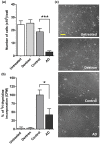Glycosaminoglycans from Alzheimer's disease hippocampus have altered capacities to bind and regulate growth factors activities and to bind tau
- PMID: 30608949
- PMCID: PMC6319808
- DOI: 10.1371/journal.pone.0209573
Glycosaminoglycans from Alzheimer's disease hippocampus have altered capacities to bind and regulate growth factors activities and to bind tau
Abstract
Glycosaminoglycans (GAGs), including heparan sulfates and chondroitin sulfates, are major components of the extracellular matrix. Upon interacting with heparin binding growth factors (HBGF), GAGs participate to the maintaintenance of tissue homeostasis and contribute to self-healing. Although several processes regulated by HBGF are altered in Alzheimer's disease, it is unknown whether the brain GAG capacities to bind and regulate the function of HBGF or of other heparin binding proteins, as tau, are modified in this disease. Here, we show that total sulfated GAGs from hippocampus of Alzheimer's disease have altered capacities to bind and potentiate the activities of growth factors including FGF-2, VEGF, and BDNF while their capacity to bind to tau is remarkable increased. Alterations of GAG structures and capacities to interact with and regulate the activity of heparin binding proteins might contribute to impaired tissue homeostasis in the Alzheimer's disease brain.
Conflict of interest statement
The authors have declared that no competing interests exist.
Figures






Similar articles
-
Age-related changes in rat myocardium involve altered capacities of glycosaminoglycans to potentiate growth factor functions and heparan sulfate-altered sulfation.J Biol Chem. 2012 Mar 30;287(14):11363-73. doi: 10.1074/jbc.M111.335901. Epub 2012 Feb 1. J Biol Chem. 2012. PMID: 22298772 Free PMC article.
-
Alzheimer-like changes in microtubule-associated protein Tau induced by sulfated glycosaminoglycans. Inhibition of microtubule binding, stimulation of phosphorylation, and filament assembly depend on the degree of sulfation.J Biol Chem. 1997 Dec 26;272(52):33118-24. doi: 10.1074/jbc.272.52.33118. J Biol Chem. 1997. PMID: 9407097
-
Interactions of neural glycosaminoglycans and proteoglycans with protein ligands: assessment of selectivity, heterogeneity and the participation of core proteins in binding.Glycobiology. 1999 Feb;9(2):143-55. doi: 10.1093/glycob/9.2.143. Glycobiology. 1999. PMID: 9949192
-
Sulfation of Glycosaminoglycans and Its Implications in Human Health and Disorders.Annu Rev Biomed Eng. 2017 Jun 21;19:1-26. doi: 10.1146/annurev-bioeng-071516-044610. Epub 2017 Feb 2. Annu Rev Biomed Eng. 2017. PMID: 28226217 Review.
-
Glycosaminoglycans: Carriers and Targets for Tailored Anti-Cancer Therapy.Biomolecules. 2021 Mar 8;11(3):395. doi: 10.3390/biom11030395. Biomolecules. 2021. PMID: 33800172 Free PMC article. Review.
Cited by
-
FGFR3 drives Aβ-induced tau uptake.Exp Mol Med. 2024 Jul;56(7):1631-1642. doi: 10.1038/s12276-024-01274-3. Epub 2024 Jul 1. Exp Mol Med. 2024. PMID: 38951140 Free PMC article.
-
The "Loss" of Perineuronal Nets in Alzheimer's Disease: Missing or Hiding in Plain Sight?Front Integr Neurosci. 2022 May 25;16:896400. doi: 10.3389/fnint.2022.896400. eCollection 2022. Front Integr Neurosci. 2022. PMID: 35694184 Free PMC article.
-
Glycosaminoglycans in Neurodegenerative Diseases.Adv Exp Med Biol. 2021;1325:189-204. doi: 10.1007/978-3-030-70115-4_9. Adv Exp Med Biol. 2021. PMID: 34495536 Review.
-
Increased 3-O-sulfated heparan sulfate in Alzheimer's disease brain is associated with genetic risk gene HS3ST1.Sci Adv. 2023 May 26;9(21):eadf6232. doi: 10.1126/sciadv.adf6232. Epub 2023 May 26. Sci Adv. 2023. PMID: 37235665 Free PMC article.
-
Protective Effects of a synthetic glycosaminoglycan mimetic (OTR4132) in a rat immunotoxic lesion model of septohippocampal cholinergic degeneration.Glycoconj J. 2022 Feb;39(1):107-130. doi: 10.1007/s10719-022-10047-x. Epub 2022 Mar 7. Glycoconj J. 2022. PMID: 35254602 Free PMC article.
References
-
- Bottaro DP. The role of extracellular matrix heparan sulfate glycosaminoglycan in the activation of growth factor signaling pathways. Ann N Y Acad Sci. 2002; 961:158 . - PubMed
Publication types
MeSH terms
Substances
LinkOut - more resources
Full Text Sources
Medical

